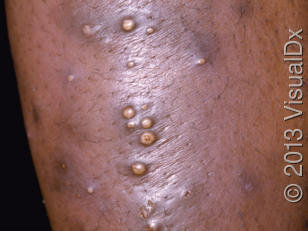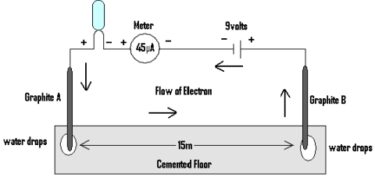How do we know that homeopathy works? It’s been used in many places around the world for over 200 years. Does this mean that it works? No. It’s used in many thousands of healthcare clinics and hospitals, we see and read of successful homeopathic treatment in journals and at conferences, and we see it being used to improve the health of animals and plants. Does this mean that it works? Not necessarily- we can’t discount the effect that the prescriber or the effect that any other variable may be having on the healing process. Nor can we discount the possibility that the entity being treated would have regained their health anyway, without homeopathy. One of the best methods of objectively determining if homeopathy works is by conducting properly designed research, and brief discussions of some recent examples of this follow.
Human Research
 Nayak C, et al. A Prospective Multicenter Observational Study to evolve the usefulness of the nine predefined homoeopathic medicines in Furunculosis. Homoeopathic Links; Spring, 2010, 23, 60-3. This observational study was conducted through 9 different government clinical research institutes across India and was coordinated by the Indian Central Council for Research in Homoeopathy (CCRH). It was designed to determine which of 9 predefined homeopathically prepared materials could be useful for the treatment of furunculosis. 397 people who were clinically diagnosed with this disorder formed the study cohort and they were treated for 3 years using a Furunculosis Symptom Score developed by the CCRH. At the beginning of the study, the results indicated an average FSS of 5.61 and this fell to an average of 1.14 by the end of the study. 85% of the patient population responded to one of the following four trial medicines: Hepar sulphuris, Antimonium crudum, Sulphur or Calcarea carbonica.
Nayak C, et al. A Prospective Multicenter Observational Study to evolve the usefulness of the nine predefined homoeopathic medicines in Furunculosis. Homoeopathic Links; Spring, 2010, 23, 60-3. This observational study was conducted through 9 different government clinical research institutes across India and was coordinated by the Indian Central Council for Research in Homoeopathy (CCRH). It was designed to determine which of 9 predefined homeopathically prepared materials could be useful for the treatment of furunculosis. 397 people who were clinically diagnosed with this disorder formed the study cohort and they were treated for 3 years using a Furunculosis Symptom Score developed by the CCRH. At the beginning of the study, the results indicated an average FSS of 5.61 and this fell to an average of 1.14 by the end of the study. 85% of the patient population responded to one of the following four trial medicines: Hepar sulphuris, Antimonium crudum, Sulphur or Calcarea carbonica.
- Nayak C, et al. A multicentric open clinical trial to evaluate the usefulness of 13 predefined homoeopathic medicines in the management of acute rhinitis in children. Indian Journal of Research in Homoeopathy, 2010, 4. 2, 23-27. In research conducted across India and coordinated by the Indian Central Council for Research in Homoeopathy, a team of scientists and clinicians sought to determine what effects, if any, homeopathic treatment had on the clinical outcomes for children suffering from acute rhinitis. 638 children suffering from clinically diagnosed acute rhinitis were given one of twelve predefined homeopathic medicines in 6C homeopathic potency and their progress followed for 7 days. They were assessed using an acute rhinitis symptom score (ARSS) at baseline and at the end of the treatment period. Over this time there was a statistically significant improvement in all of the signs and symptoms observed. The most frequently prescribed medicines were Nux vomica, Merc sol and Belladonna.
- Goda C, et al. Role of homoeopathic treatment in scabies infection in adivasi children attending ashram shalas (resident schools). Indian Journal of Research in Homoeopathy, 2010, 4, 2, 33-40. Using a prospective, randomized controlled, single blind study design, a group of Indian researchers investigated the capacity of homeopathic therapy to relieve a cohort of 300 Indian schoolchildren of scabies. The children were divided into three treatment groups, i.e. constitutional group, acute / sector group and placebo group. Scabies infection was diagnosed by a dermatologist and graded according to the severity of infection and children were observed for 2 years. All treatment groups were subjected to standard hygienic measures during the course of the study. Results were analysed at the end of each year and by the end of the study period it was found that 90% of the children from the constitutional group improved at the end of the 1st year whereas 27% from the acute and 4% from the placebo group improved. At the end of the second year, the rate of improvement of the constitutional group rose to 98% whereas 48% from the acute and 12% from placebo group improved. The prevalence of scabies in the school dropped from 52% to 17% at a time when the prevalence of scabies in the residential schools in the area did not show any reduction.
4. Zanasi A, et al. Homeopathic medicine for acute cough in upper respiratory tract infections and acute bronchitis: a randomized, double-blind, placebo-controlled trial. Pul Pharmacol Ther, 2014, 27, 1, 102-8. Using a randomized, double blind, placebo controlled clinical trial design, the authors of this study tested the efficacy of a homeopathic syrup in treating cough arising from Upper Respiratory Tract Infections (URTI). 80 people with an URTI-related cough were treated with either the homeopathic syrup or a placebo for a week, and recorded cough severity in a diary by means of a verbal category-descriptive score for two weeks. Sputum viscosity was assessed with a viscosimeter before and after 4 days of treatment and patients were asked to provide a subjective evaluation of viscosity. On analysis of the results it was shown that in each group, cough scores decreased over time, however, after 4 and 7 days of treatment, cough severity was significantly lower in the homeopathic group than in the placebo group. Sputum was collected from 53 patients: in both groups, viscosity significantly decreased after 4 days of treatment and viscosity was significantly lower in the homeopathic group than in the placebo group.
- Gupta G, et al. Evidence based clinical study to assess the usefulness of homoeopathic medicines in patients of Benign Prostatic Hyperplasia. Indian Journal of Research in Homoeopathy, 2010, 4, 2, 49-56. In a collaborative observational study between the Indian Central Council for Research in Homoeopathy and the Lucknow Homoeopathic Research Foundation, 43 men diagnosed with benign prostatic hyperplasia were given one of 20 predefined homeopathic medicines and monitored for 12 months. Assessment was done before and after treatment via the International Prostate Symptom Score (IPSS), ultrasonography, uroflowmetry and Prostate Specific Antigen (PSA). After comparing pre and post treatment results, the difference in mean values of IPSS, Prostate weight, PSA and average flow rates were found to be statistically significant. Maximum Flow Rate and Post Void Residual Urine (PVRU) were improved but statistically not significant. The most frequently prescribed medicines were Lycopodium, Pulsatilla, Sulphur and Calcarea carb.
6. Chand KS, et al. Homeopathic treatment in addition to standard care in multi drug resistant pulmonary tuberculosis: a randomized, double blind, placebo controlled clinical trial. Homeopathy, 2014, 103, 2, 97-107. In the face of a global increase in the number of cases of human multiple drug resistant tuberculosis (MTRTB), this research was conducted to determine if individualised homeopathy, in addition to standard care, could improve the prognosis for people suffering from this disease. A randomized, double blind, placebo controlled study was conducted with 120 people diagnosed with MDRTB over 5 years. They were randomised to receive standard regimen + individualised homeopathic medicine (SR + H) or standard regimen + identical placebo (SR + P). The outcome measures were sputum conversion, changes in chest X-ray (CXR), haemoglobin, erythrocyte sedimentation rate (ESR), weight gain, and clinical improvement. An analysis of the results showed an improvement in most of the outcome measures associated with the use of homeopathy, in particular, weight gain, ESR and mean haemoglobin and CXR.. In addition, the cure rate was 11.4% more in SR + H group as compared to placebo group.
- Gmnunder R, Kissling R. The Efficacy of homeopathy in the treatment of chronic low back pain compared to standardized physiotherapy. Zeitschrift für Orthopädie und ihre Grenzgebiete, 2002, 140, 5, 503-8. In this controlled, randomised, prospective study, 43 people suffering from chronic low back pain were treated for two months either by homeopathy or by standardised physiotherapy. Assessment based on the initial and final clinical investigations, an Oswestry questionnaire, and visual analogue scale, found that the most successful method of treatment was homeopathy.
Animal Research
1. Sarkar A, et al. Anti-rheumatoid and anti-oxidant activity of homeopathic Guaiacum officinale in an animal model. Homeopathy, 2014, 103, 2, 133-8. Guaiacum has been used for generations in homeopathy both constitutionally and specifically for musculoskeletal disorders. The aim of this study was to evaluate the anti-rheumatic and anti-oxidant activity of homeopathic preparations of Guaiacum officinale on rats. To do this, a group of rats suffering from rheumatoid arthritis were divided into 6 groups and received Sham control, Arthritis control, Standard treatment (indomethacin), Guaiacum mother tincture, Guaiacum 30C or Guaiacum 200C.These groups were given these interventions for 5 days and anti-rheumatic activity was examined through physical, urinary, serum parameters. These included body weight, ankle and knee diameter, urinary parameters (hydroxyproline), glucosamine, calcium, creatinine, phosphate, serum acid phosphatase, alkaline phosphatise, gamma-glutamyl transferase, lipid peroxidation, glutathione, superoxide dismutase,, catalase, serum GGT and serum interleukins. When compared to the controls, treatment with all of the 3 forms of Guaiacum was associated with a normalisation of these parameters.
- Bellavite P, et al. Mice behavioural models with pooled data analysis of Gelsemium studies and new findings about Ignatia and Aconitum. Int J High Dilution Res, 2011, 10, 36, 198-200 Proceedings of the XXV GIRI Symposium and VIII CBFH; 2011 Sep 04-07; Foz do Iguaçu (Brazil) 198. In a follow-up to previous work done in this area, researchers from the University of Verona in Italy investigated the anxiolytic properties of homeopathically prepared materials on mice. Using a randomized, blinded and controlled protocol, mice were assigned to be given several one of several homeopathic potencies of Gelsemium, Aconite, Ignatia or material doses of positive controls (diazepam or buspirone) or a negative control (ethanol and water). They were exposed to stressful environmental situations (open field test or light-dark tests) and assessed for anxiety in relation to these environments. Compared to the controls, cumulative analysis of the results demonstrated a highly significant effect of Gelsemium 5C and 30C in both tests and Ignatia 9C in the Light-Dark test. The results indicate an anxiolytic rather than a sedative effect.
In-Vitro Research
- Bandyopadhyay B, et al. Decreased intensity of Japanese Encephalitis virus infection in chick chorioallantoic membrane under influence of ultradiluted Belladonna extract. Indian Journal of Research in Homoeopathy, 2010, 4, 2, 1-6. The inner membrane of the chicken egg (the chorioallantoic membrane) has long been used as a platform for viral research, with pock formation on these membranes registering the presence of viral growth. This tool was used by a team of Indian researchers looking at the potential of homeopathically prepared Belladonna to prevent the growth of Japanese Encephalitis virus (JEV). To do this, membranes were inoculated with Belladonna 3C, 15C, 30C, 200C or a control substance. They were then inoculated with JEV and incubated at 37 degrees C. For 14 days and examined for pock formation. When compared to the controls, it was found that the use of all of the Belladonna potencies was associated with a significant reduction in viral pock formation, indicating an inhibition of growth.






